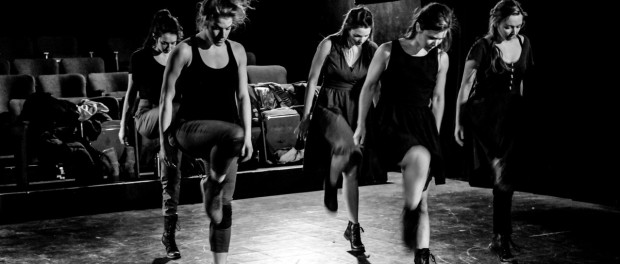The Kantian Choreographer. Morin-Robert’s Coming and Going.
Immanuel Kant, in his Analytic of the Sublime, posited that there could be no rules, laws or boundaries within the tradition of art and for taste within the beauty of an object. He argued in favor of the autonomy of art, its independence from the claims of morality and science, and finally its essential value as a realm of pure play and deliberation in itself. Performance artist, Stephanie Morin-Robert is a live example of Kant’s doctrine that stands with regard to notions of taste and beauty, as well as the willingness to explore beyond the boundaries and canons of good taste.
Stephanie Morin-Robert’s Coming and Going outlines a visual tactic, a mode of watching and at the same time interacting with performance art. This medium offers one such approach of sense experience: sight and sense of sound perception. This particular performance is an expression associated with the experience of sensual memorizing within visual representation. It is a kind of spectatorship in which the audience may give themselves over to an entire scene, rather than just identifying themselves with characters. Morin-Robert’s concept of performance provides an alternative framework for discussing the kind of strategy in relation to multiple senses, affect and embodiment.
ON CONTEMPORARY DANCE
Everyone has a different way of defining contemporary dance. I don’t think there is a correct answer to this question, because everyone has their own way of defining, creating, performing and watching contemporary dance. It’s nothing, everything and anything, all at once. Personally, contemporary dance is exploring the fine line between movement and stillness, light and dark, reality and fiction. It’s where two worlds collide and become something new.
ON CONNECTION BETWEEN AUDIENCE AND CONTEMPORARY DANCE
As a choreographer, I see voice as a tool to support a vivid storyline, but I also see it as an extension of the body. I incorporate movement to allow the story to breathe, to expand, to shift and to trace through time and space. I hope this recipe allows me to make contemporary dance and spoken word more accessible and relatable to a larger audience, letting them choose to connect one way or the other.
ON SPACE
After our residency in Nova Scotia in the Bay of Fundy, there was a major shift in the work. The connections are ever shifting and the finished product emerges from these shifts. This work is much more internal and dark, about people connecting and leaving and not knowing why they leave or whether they’ll come back. We were all stunned by the speed and power of the massive tide changes made every day.
The movement of water, the attraction to light, the pull of the earth, the power of wind — all have the ability to move us. Everything is always in motion. In stillness, the interior of the body continues to move like a fire or an ocean current. When standing chest-deep in a rising tide, no matter how still one stands, they are still moving, with each wave, one’s whole body circles with it. Every movement leads to the next, never quiet and even in stillness, there is motion.
CONNECTING WITH YOUR BODY
Our bodies are our tools, and keeping them in tune both mentally and physically is very important. Movement and choreography has always been an extremely therapeutic thing for me, and I would not be the person I am today if it was less present in my life. It has helped me (and still does) channel emotions, organize my thoughts and let out my steam. It’s what carries me thought both good and bad relationships, conflicts and everyday life. Understanding your body is a very important thing, whether to dance or not.
When I was 2 years old, I was diagnosed with retinoblastoma, a tumor on the retina of my left eye. Not very long after the diagnosis, I had my eye removed to save my life. I don’t remember actually ever being able to see with two eyes, because I have been this way for as long as I could remember. Being blind from the left eye is what pushed me to search for a different understanding of the body. It’s though movement that I gained a stronger awareness of the left side of my body and surroundings.
That has been said, not only are our bodies our tools, but so is dance.
Coming and Going along with CYCLe 2 by Kimberley de Jong is at Théâtre Prospero (1371 Ontario E) on Feb 20-22, 7:30 p.m. and Feb 23, 4 p.m.
1 Trackbacks & Pingbacks
Comments are closed.










